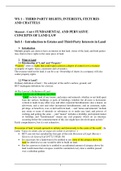Summary
Summary LAND LAW complete book summaries and notes
- Module
- LAND LAW (LND)
- Institution
- University Of Law (ULaw)
LAND LAW complete book summaries and notes of all 8 units covered in class. It is very well organised and structured, it includes all book readings, paragraphs and topics covered in class. With these notes I achieved a DISTINCTION!
[Show more]



